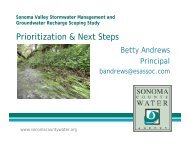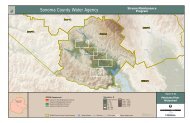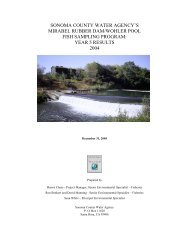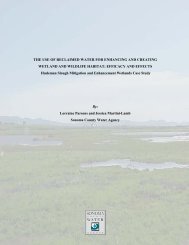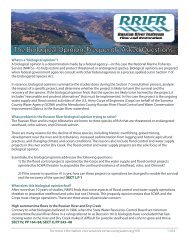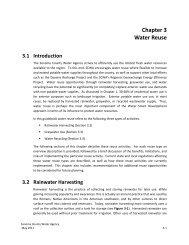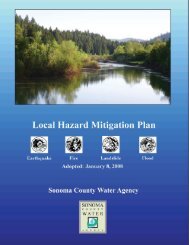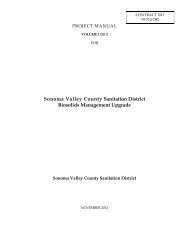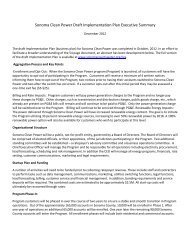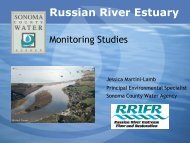Hydrography of the Russian River Estuary - Sonoma County Water ...
Hydrography of the Russian River Estuary - Sonoma County Water ...
Hydrography of the Russian River Estuary - Sonoma County Water ...
You also want an ePaper? Increase the reach of your titles
YUMPU automatically turns print PDFs into web optimized ePapers that Google loves.
Executive Summary<br />
Circulation, stratification and water properties were monitored during late summer 2009<br />
in <strong>the</strong> <strong>Russian</strong> <strong>River</strong> estuary– a dry year in which river flow was lower level than normal.<br />
Attention is directed at conditions in a month-long closure event in September-October.<br />
A dense lower layer <strong>of</strong> high-salinity water was trapped in <strong>the</strong> estuary when <strong>the</strong> mouth<br />
closed, with stability increasing over time as well as an expansion <strong>of</strong> stable stratification<br />
as saline waters intruded into <strong>the</strong> inner estuary. Within a week <strong>of</strong> strong stratification<br />
being established, <strong>the</strong> near-bottom waters became hypoxic. At mid-depth penetration <strong>of</strong><br />
light led to photosyn<strong>the</strong>sis and a stable layer in which oxygen levels were high during<br />
<strong>the</strong> day. At similar depths, <strong>the</strong>rmal radiation was also trapped and water temperatures<br />
were greatest. The thin surface layer was well mixed and in equilibrium with <strong>the</strong><br />
atmosphere in terms <strong>of</strong> both dissolved oxygen and temperature. Stratification and deepwater<br />
hypoxia persisted until tidal action returned with opening <strong>of</strong> <strong>the</strong> mouth in October.<br />
This report is preceded by a data report (Behrens & Largier 2010), in which all field data<br />
are plotted and details are provided on instrument deployments. In this report, core<br />
sections address (i) water budget and seepage analysis, (ii) tidal and diurnal currents,<br />
(iii) hydrographic structure – salinity, temperature, dissolved oxygen, (iv) stratification<br />
and water column stability, (v) salt and dissolved oxygen budgets.<br />
Central to this study and <strong>the</strong> value <strong>of</strong> <strong>the</strong> <strong>Russian</strong> <strong>River</strong> estuary as habitat for juvenile<br />
salmon is <strong>the</strong> strong stratification that develops due to trapping <strong>of</strong> a salt layer in <strong>the</strong><br />
estuary when <strong>the</strong> mouth closes. The salt-stratified closed estuary is non-tidal and a<br />
wind-driven diurnal seiche takes on particular importance in <strong>the</strong> horizontal redistribution<br />
<strong>of</strong> salt as well as in raising <strong>the</strong> possibility <strong>of</strong> vertical mixing and eventual breakdown <strong>of</strong><br />
<strong>the</strong> stratification. Breakdown <strong>of</strong> stratification appears essential for re-oxygenating <strong>the</strong><br />
hypoxic bottom waters and reducing mid-depth temperatures. A significant apparent<br />
loss <strong>of</strong> estuary water through <strong>the</strong> sand barrier (~60cfs) is important in flushing <strong>the</strong><br />
surface layer (residence time order 10 days), but it plays only a minor role in reducing<br />
<strong>the</strong> salinity <strong>of</strong> <strong>the</strong> lower layer within 1-2 km <strong>of</strong> <strong>the</strong> barrier beach.<br />
The most significant advances in future understanding in support <strong>of</strong> improved<br />
management <strong>of</strong> <strong>the</strong> estuary are likely to come from (i) linking water property<br />
distributions to salmon habitat value and extent, (ii) assessment <strong>of</strong> <strong>the</strong> extent <strong>of</strong> hypoxia<br />
immediately following breaching after a long closure, (iii) assessment <strong>of</strong> turbulence,<br />
vertical mixing and <strong>the</strong> potential for breakdown <strong>of</strong> stratification, (iv) a fuller quantification<br />
and understanding <strong>of</strong> <strong>the</strong> diurnal wind-driven seiche, (v) a fuller quantification and<br />
understanding <strong>of</strong> seepage losses through <strong>the</strong> sand barrier, and (vi) a fuller quantification<br />
and understanding <strong>of</strong> berm overflows and wave overwash.<br />
3




